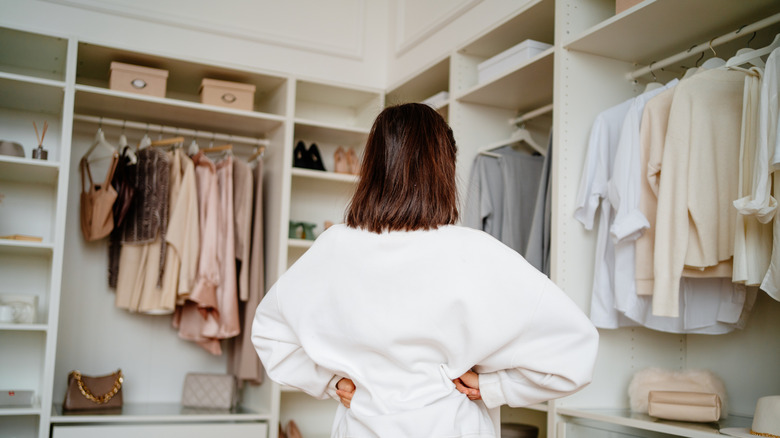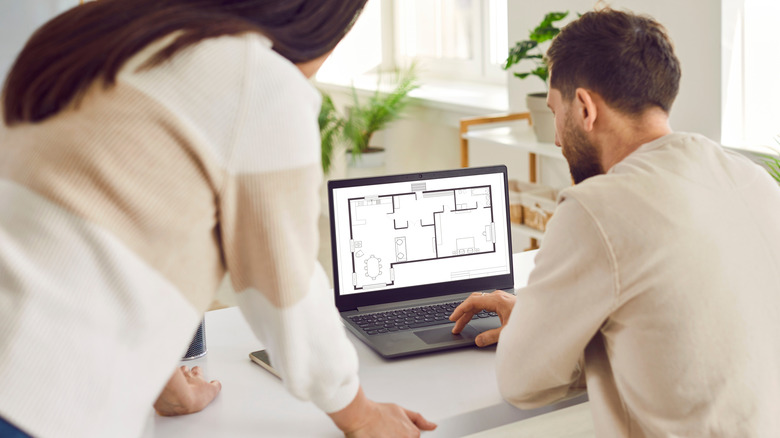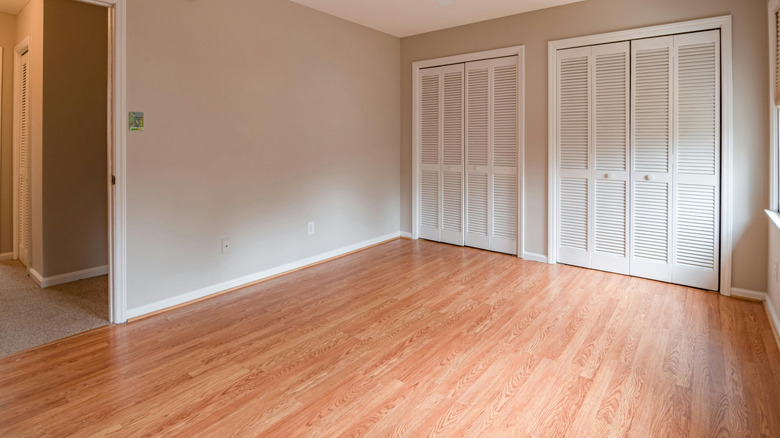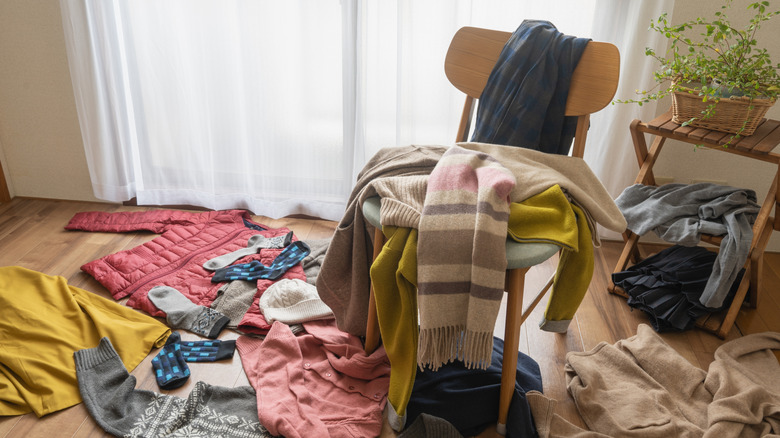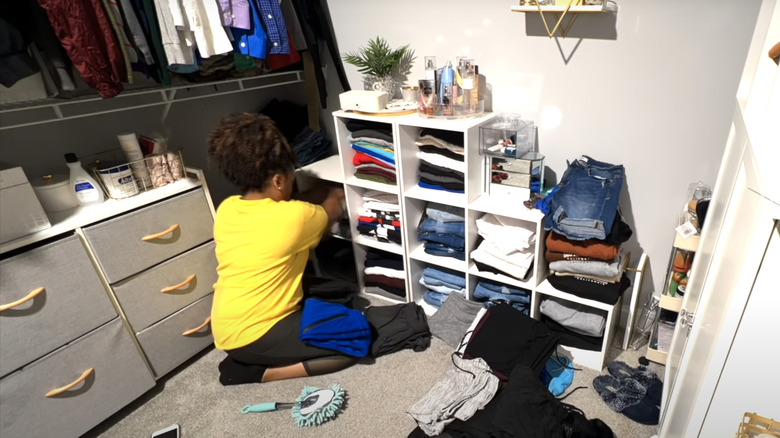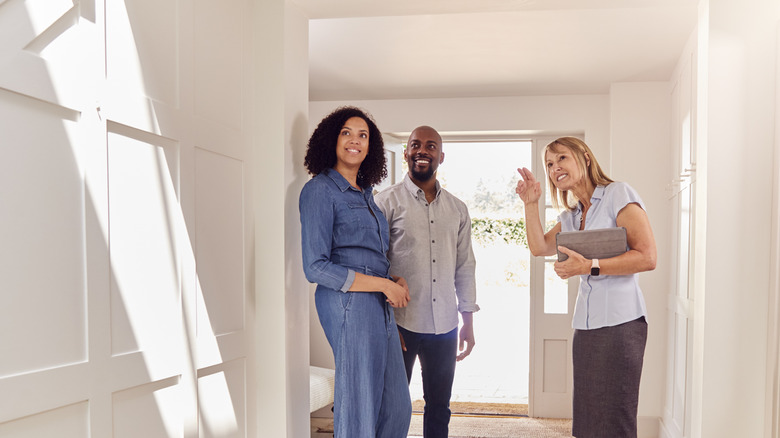How To Decide If A Walk-In Or Built-In Closet Is Best For Your Home And Lifestyle
We may receive a commission on purchases made from links.
If your clothing shelves and rails feel hard to organize no matter what you try — a closet remodel could make all the difference. Done right, a closet renovation can help make your space add up to a dream home that's functional and tailored to your life. But like kitchen upgrades, closet renos can be full of decisions, and the first one might be the big question of whether to allocate space and money to a luxurious walk-in, or save cash and floor area with a built-in. The route you choose will impact your daily life and have long-lasting consequences, and it can be difficult to pick between the two types, as both have their pros and cons.
Built-in closets usually have a narrow strip of storage space installed along one wall. They're more simple in design, uncomplicated to install, and easier to manage. In contrast, walk-ins range from about 60 to over 100 square feet, tend to hold more clothes, and can be outfitted with dozens of different closet features, such as shoe spinners and vanity areas. It might feel like deciding between a walk-in or built-in should be simple: If you have a larger wardrobe, then you need the extra space of a walk-in, and if you're more of a minimalist when it comes to attire, a built-in. But these aren't the only things to weigh. Many factors should come into play before you decide on the closet that's best for you, your family, and future household members, including your personal preferences, schedule, budget, house setup, and more. Ensure you've considered everything by checking out the list of closet-clinching factors below.
Determine if your budget covers a built-in or walk-in closet
One of the most important considerations in any home renovation project is the budget. Besides figuring out how much money you can afford to spend on the project, it's also a good idea to factor in your home value. It's recommended not to spend more than 10% to 15% of your home's total value on a single room, such as a walk-in closet. Therefore, if you have a smaller house, splurging on a huge walk-in could be a poor financial choice, even if you have saved up and can afford to part with the money. This is because you probably won't be able to recoup the cost when it comes time to sell, especially if the update does not keep with the overall home value.
Decide how much money you want to allocate to the closet project, and start calculating what you can get for that amount, minus a 10-20% contingency. Built-in closets tend to be cheaper than walk-ins. They require less construction, smaller closet systems, fewer materials, etc. Built-in closets usually cost around $500 to $3,800, while walk-ins range from $1,000 to $8,000. The biggest price drivers include materials used and add-on features, such as specialized drawers. Fortunately, there are lots of ways to make your budget work harder, and if you have the time and skill to do some of the work yourself, you could push down the costs. For instance, you can opt for a customizable closet system like the IKEA PAX and make it look built-in. There are lots of IKEA PAX DIY upgrades you can make, ranging from installing trim for a seamless built-in look, to creating a walk-in space by placing PAX units parallel to each other.
Determine which closet type is compatible with your home's infrastructure
A house's infrastructure can limit renovation and design ideas. To expand a closet, structural walls, drainage pipes, and electrical connections may need to be rearranged. A walk-in is much more likely to have limitations since it isn't just a narrow storage installation — and usually involves adding, dividing, or retrofitting a room. Walk-in closets don't just require more space, they may also need extra electrical outlets and lighting installed, as well as ventilation, and damp proofing if placed off a bathroom. The cost of changing existing infrastructure can dramatically hike up building costs, pushing a project beyond budget limits.
Regardless, even if you have the money to make more costly changes, a walk-in closet might not be a viable option if infrastructure doesn't permit it. Even if it works structurally, you shouldn't install a closet in an awkward space. Putting it directly next to a door or archway may make the area feel cramped. Entrance ways also shouldn't interfere with the existing flow of a room. And if your home's layout forces you to locate the walk-in closet too far away from the bedroom, this could cancel out the convenience of having the extra wardrobe space.
Decide whether you need more bedroom space or closet space
Like most choices in life, you might have to make some sacrifices, no matter which option you pick. What would you rather have: more bedroom space or a larger closet? Is it more important to have accessories, clothes, and shoe storage or to have a spacious bedroom? In an exclusive homeowner survey by House Digest, over 79% of people claim to prefer walk-in closets, showing many are willing to sacrifice some space for more storage.
When building a walk-in, you may have to reduce nearby rooms to expand the closet. If these rooms are already too cramped, the walk-in closet could take away valuable space. On the other hand, if these rooms are small and unnecessary, one might be perfect for repurposing into a large closet. Average home sizes were smaller before the '80s, and walk-in closets weren't commonplace. Annexing an adjacent room in an old home and converting it into a walk-in could be the ideal solution. But, if you don't have an unused room backing onto your bedroom, you will need to sacrifice floor area from the main bedroom, usually at least 6 feet for the width, and 7 feet for the length. Failing that, you can opt for a mini walk-in that measures a minimum of 4 feet by 4 feet, but such cramped quarters could lack functionality.
Consider if you have enough clothes to fill a walk-in closet
Taking inventory of your wardrobe is a great way to determine whether a built-in or a walk-in closet is more realistic for your lifestyle. Just because it seems like everyone else is installing walk-ins doesn't necessarily mean you should follow suit. Take a look at your current clothing collection, including your accessories, bags, clothes, shoes, and organizers. If all of these items can easily fit in a built-in closet, a walk-in may be a waste of room space. On a side note, many closet installation companies offer personal consultations if you're having trouble gauging how much space you need.
And before you invest in a walk-in to house a large clothing collection, consider pruning some pieces. Ginny Snook Scott, chief design officer of California Closets, told The Wall Street Journal that a mere 20% of the clothes most people own actually see regular use. If this statistic applies to your wardrobe, donating, selling, and trashing unused clothing pieces could free up a lot of space — and a built-in closet might be the move once you've downsized. To help get you started, here are three simple steps for the ultimate closet declutter: Getting rid of items that don't fit your frame or lifestyle, ones that are hard to style, and any superfluous doubles. You can also try backward decluttering to organize your closet, or use the "out in the open" tip to perfectly prune closet items.
Assess how important fashion is to you and whether you need a diverse wardrobe
If the idea of downsizing caught your interest, you should evaluate your lifestyle and consider whether a vast wardrobe is adding value to your life. People who love fashion, dressing up, and experimenting with new looks may consider their closet as a part of their hobby. They naturally purchase more items to wear and create a wider range of outfits, making a larger closet more necessary. On the other hand, some people don't care to try new trends. They're fine wearing the same combinations of outfits that they've always found attractive and comfortable. Neither way of being is better than the other, but each one requires a different type of closet.
Fashion-savvy individuals are the ideal candidates for a walk-in closet to house their diverse wardrobe of casual, fancy, and special occasion outfits. A walk-in closet has more organization features and storage opportunities, making it easier to find specific pieces, keep less-used items from getting lost, and properly store collector's pieces. In contrast, people who thrive with a more minimized wardrobe should condense it into the reliable, go-to outfits they wear on the regular. When properly organized, most built-in closets should have enough space to house a select clothing collection.
Consider others in your household and whether you'll ever share your closet space
Closets aren't only built for individual use. Don't forget to consider whether this closet will be a shared space. Couples must work together to organize and split their closets, and larger designs make it easier to clearly divide two people's belongings. This is especially important when couples have different organization styles — someone who absentmindedly stuffs clothes onto shelves and an orderly-minded partner will inevitably clash, especially if they have to share a small amount of closet space. Therefore, when more than one person is involved, a walk-in could be the best bet, as it allows for more storage area.
Even if you're currently single or only have one child, think about future possibilities. Do you plan to find a partner or have more children? If so, a walk-in closet might be a better long-term investment, as a new built-in may work temporarily but be insufficient when more people move in. On the other hand, if you don't plan on sharing your closet space, a well-planned built-in may be adequate for now and the future.
Consider how much time you have to clean and organize
Once a built-in or walk-in closet is finished, stocked, and organized, the work isn't over. Closets of any size require regular upkeep, including dusting, sweeping, vacuuming, and general cleaning to keep them and their contents in good shape. The bigger the closet, the more shelves, drawers, furniture, and floor space there will be that need routine cleaning. During deep cleaning, all clothes must be removed. This is especially tedious with walk-ins. Built-in closets are usually much simpler in design, meaning fewer shelves and drawers need cleaning and fewer items need to be moved around.
Most people would rather reduce their cleaning regimen than add to it, as the average American already spends about 300 hours a year cleaning their home according to research by Maid Brigade. Consider whether you'll have time to clean all the nooks and crannies that come with a walk-in closet. If you don't have the time, can you hire an occasional cleaning service to lighten the load? If a hectic schedule and tight finances won't permit routine cleaning of a walk-in, you may want to go with a built-in instead.
Look at how your closet choice could affect your spending and saving goals in the future
Another way to decide what size closet is right for you is to identify whether you're a saver or a spender. According to research insights from Common Objective, the average shopper here in the US buys a new item of clothing every week, and The Wall Street Journal reports that we're purchasing 500% more clothing than in 1980. House sizes and inside storage have also grown, giving people more space to stow their fashion finds. Households with walk-in closets can fit more personal purchases inside, and the extra space can also make it feel like you possess fewer items than you actually do.
In short, a larger closet doesn't just cost more money to build; it can also cost more money to sustain. The increased storage capacity can encourage purchases, and having free space to fill can trick one into buying trivial items instead of making thoughtful additions. In contrast, a built-in has limited space. This physical restriction may help you meet saving goals if you only have room for what you truly want and need.
Dwell on how a smaller closet could benefit your mental health
Buying new clothes triggers instant gratification, but too much clutter can have mental health impacts. A study published in the Personality and Social Psychology Bulletin revealed that women who described their homes as cluttered were more likely to experience elevated cortisol levels throughout the day. Having a large closet filled with items may seem like a dreamy luxury, but it could negatively impact your mental state if it's crowded and unorganized.
Many people have a lot on their plate, balancing family, friends, school, work, and other individual factors. A big closet overflowing with options could make you more stressed and even contribute to decision fatigue. Decision fatigue can set in when you're overloaded with daily decisions, rendering it harder to function and even make small choices. A built-in closet simplifies your options when you're getting ready for the day. You have fewer choices to make, which can start mornings off with less stress and a smaller mess, giving you more bandwidth for the things that truly matter. Of course, there is a flip side to this. If a truly awkward built-in or reach-in closet is making it hard to store and access even a streamlined wardrobe, the extra space and organizational features a walk-in offers could also be a path to reduced stress.
Think about how your closet choice affects your long-term house goals
If individual feelings aren't enough to make you decide, turn the closet choice into a business decision. Your chosen closet type can have financial consequences and impact your house value and salability. Walk-ins cost more to build. However, the 2019 Home Remodeling Impact Report from NAR Realtor revealed that closet remodels can add roughly $2,500 to a home's selling price, and homeowners can recoup up to 40% of the cost. A Canadian Home Builders' Association survey also revealed that walk-in closets rank among the top amenities desired by homebuyers.
Bearing these statistics in mind, a walk-in closet could be an advantageous option if you plan to list or rent out your home in the future. While you probably won't recoup the full cost of a walk-in closet, adding this feature to your home could make it easier to sell and help your listing stand out in a competitive market. That said, although walk-ins are highly coveted, a built-in closet isn't necessarily a bad choice when selling either. Smaller houses might do better with a built-in closet because it won't take away from the overall spaciousness of a room, which can be a considerable selling point. There are also various ways to make a built-in closet seem larger, as well as smart organization solutions that can make it feel almost as fancy as a walk-in, such as drawer elements, valet rods, and pull-out pants racks, like the Rev-A-Shelf Pull Out Wire Frame for trousers.
